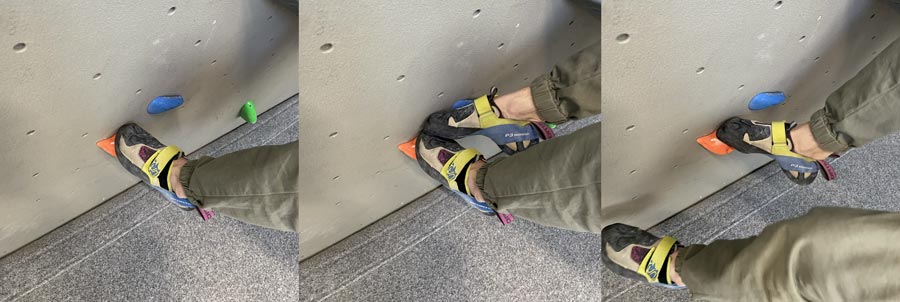The foot swap is a crucial technique for climbers looking to progress in their climbing ability. Whether you are just starting out or are an experienced climber, having a strong understanding of this technique will greatly benefit you on the wall.
In this article, we will delve into the fundamentals of foot swapping, including what it is, why it’s important, and how to perform it correctly. We will also discuss common mistakes that climbers make while swapping feet and offer tips on how to practice this technique effectively.
📚 This article is part of a wider guide: Climbing Technique 101
What is the foot swap?
The Foot Swap is a technique that allows the climber to change the position of the feet while climbing. It’s purpose is to achieve improved balance, stability, and control by shifting the feet to a more advantageous position. Foot Swaps can provide greater reach, make challenging moves more manageable, facilitate proper flagging, and so forth.
Swapping feet is a basic movement in climbing that often comes naturally to climbers, but performing it with proper technique and precision on smaller holds requires practice.
Practice is well worth the effort as it can greatly improve a climber’s performance. Whether you are just starting out or have been climbing for years, refining your foot swap technique can have a positive impact on your climbing experience.
📚 Start Practicing! Continue reading: Technical Climbing Drills
how to perform a Foot Swap
Most climbers, including beginners, have likely attempted a foot swap at some point during their time climbing. However, there are different techniques for performing a foot swap, and only one method is considered truly secure for use on small footholds.
Here’s how you can perform a proper foot swap.
Place the foot you want to swap on top of the foot that is already on the foothold, and gradually transfer your weight to create a smooth, controlled foot swap.

It’s important to apply pressure to the tip of the bottom foot and remove it slowly from the foothold, ensuring that the top foot is securely positioned and ready to take over the foothold.
This is the best way to swap feet as it allows greater control and stability during the transition. However, mastering this technique takes some practice.
common mistakes while Swapping feet
- Hurrying the swap: a proper foot swap requires precision and rushing the foot swap will lead to a sloppy technique which does work on many occasions but will fail once the foot holds become smaller.
- Not looking at your feet: beginner climbers often neglect to keep their focus on their feet while making moves, including during a foot swap. However, to perform a successful foot swap, it’s important to keep your eyes on the foothold to ensure a precise and accurate swap.
- Improper weight distribution: failing to properly distribute the weight between your top and bottom foot can cause you to slip and fall.
- Relying too heavily on hand holds: most beginners will rely on their hand holds to do the foot swap. Oftentimes make a little hop as they swap their feet knowing that their hands will protect them from falling. This only works on easy problems and will not transfer to advanced problems and routes.
practicing the foot swap
Practicing the foot swap will take some time. You should start practicing them on easy routes, ideally during the warmup phase of your climbing session. I suggest you practice foot swaps before every climbing session until you are confident enough to use the technique on more difficult problems or routes.
Pay close attention to your technique while you are practicing the foot swap and don’t rush it. Remember to look at your feet and slowly interchange your feet on the foothold. Don’t just jump, be precise.
when to swap feet in climbing
You should swap feet in climbing when you need to:
- Improve balance and stability: By moving your feet to a different position, you can often find a more stable stance and improve your balance. This can be especially helpful when making challenging moves or when reaching for a far-away hold.
- Increase reach: By swapping your feet, you can often reach further and make a move that was previously out of reach.
- Set up for a flag: Flagging is the act of counterbalancing your body by using one leg to support your weight while reaching for a hold with the other. Swapping your feet can allow you to set yourself up in a better position for a flag, making it easier to maintain your balance and complete the move.
- Transfer your weight: When moving from one hold to the next, you may need to transfer your weight from one foot to the other. Swapping your feet can help you do this smoothly and efficiently.
Climbing Technique 101
Knowledge is power! Enhance your climbing progress by exploring our other articles on Climbing Techniques.